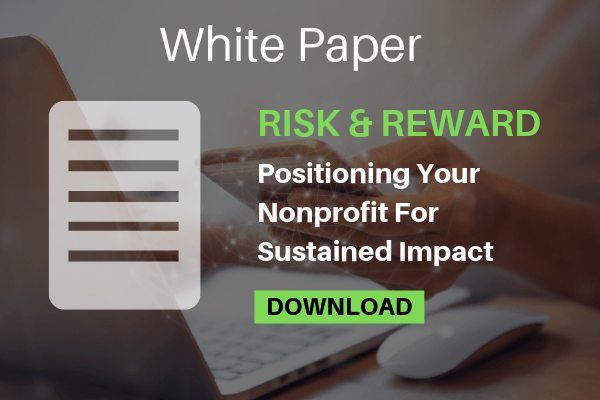Every nonprofit faces risk, but it doesn’t have to be a liability. Learn to take a holistic view of risk and use the unexpected to your advantage.
What if your funding was cut by half overnight? It might sound impossible, but given the precarious financial situation most nonprofits face, it’s a very real risk.
You may be laser-focused on your mission, but for foundational donors or government grantors, that mission is just one of many priorities. Deciding to cut or suspend funding seems like a minor decision to them, but for you, it incites an existential crisis.
The nonprofit sector is unpredictable by nature, so risk is unavoidable. Acknowledging that it’s inevitable is important, but so is treating it like an opportunity as well as an uncertainty. Managing and leveraging risk can actually help nonprofits grow their financial foundation and advance their mission in the process. It requires nonprofits to walk a fine line, but when it’s done well it puts organizations in a proactive position that would be impossible otherwise.
Risk Leadership: A New Concept for Nonprofits
To understand just how fine the line is, consider a workforce-development nonprofit local to us. They took the risky step of opening a new office in order to expand their community impact. Shortly afterwards, however, a major grant was cut and the new office became a financial liability. Ultimately, the nonprofit closed because the risks overwhelmed the rewards.
The problem afflicting this non-profit and many others is a failure to lead in terms of risk. Most nonprofits practice some sort of risk management, but it’s only part of the equation. Risk leadership encompasses assessing, managing, and mitigating risk so that the unexpected never catches nonprofits off guard. Instead of adopting a reactive, crisis-management approach, risk leadership enables forward-looking planning.
Nonprofits increasingly see risk leadership as essential to their sustainability, but that doesn’t mean embracing a new approach is easy. Staff and board members alike must work collaboratively to explore risk in depth, not just through a fiduciary lens. Risk in all forms (strategic, financial, mission-based) must be considered collectively, otherwise, the organization is working with self-imposed blinders on.
What does this look like in practice? Consider a youth-sports organization that decides to turn down a grant because it doesn’t cover the full cost of service delivery. The nonprofit takes a short-term financial hit, but, as a result, it’s able to redirect resources to finding funding streams that will cover full costs. Risk now can lead to rewards later, but only at nonprofits that strive to understand risk instead of simply avoiding it.
Taking a Holistic Approach to Risk
Financial risk is just one of many factors that nonprofits need to evaluate in order to lead on this issue. As important as the purse strings are, insufficient cash flow isn’t the only thing that can hold nonprofits back. A holistic approach to risk considers all the factors that can compromise a nonprofit:
- Leadership, Governance, & Strategy – Risks include problems with policy, planning, monitoring, and oversight, especially in terms of board engagement.
- Personnel & Administration – Risks include loss of staff, ineffective HR policies, bad real estate deals, poor information security, or incomplete administrative policies.
- Finance – Risks include poor financial practices, performance, or oversight as well as issues with controls, monitoring, and reporting.
- Compliance & Legal – Risks include neglecting quality monitoring and improvement, misunderstanding regulatory requirements, and failing to manage compliance with contractual or grant obligations.
- Programs & Services – Risks include poor program monitoring and declining quality.
- External Environment –Risks include unexpected shifts in the community, market, or government, along with reputational risks from bad PR.
Taking a holistic approach to risk is crucial right now because the landscape is not getting any easier for nonprofits. Recent research shows that 7% of nonprofits are technically insolvent, 30% have insufficient cash reserves, and another 30% have lost money over the last three years. Considering that those are just financial risk – one out of six factors – nonprofits may be less stable than they realize.
Our goal with this piece is to introduce you to the concept of risk leadership at a time when it’s more urgent than ever. To really embrace this concept, however, you need to go more in-depth than we have here.

